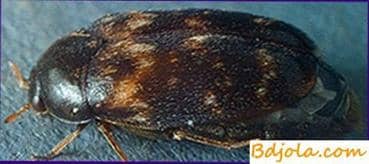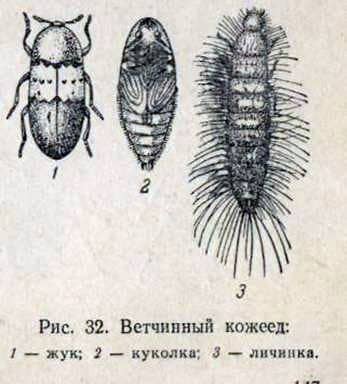
Hamster kozheed (Dermestes lardarius L.) – a beetle 8 mm long, 3.5 mm wide, black, with transverse grayish-brown stripes on the anterior part of the elytra, on a strip of 6 black dots.

Eggs he lays in the hive litter, their dimensions are 2 X 0.6 mm. From the egg, a larva is excreted, which grows from 2 to 15 mm. Its body is white, covered with red-brown hairs. The rear end is black-brown in color. The larva pupates, an ivory pupa, 8×3 mm in size. At this stage, wintering takes place.
Ham, as the name suggests, is a parasite of animal products, it eats skins, skins, furs, ham, sausage, lard, bristles, hair, horns, etc. This parasite is often found in poultry houses and pigeons. It is also often found in weak bee colonies, in which no rubbish is removed. In hives, a ham eater feeds on a warming material, a tree of frames and a hive, drilling holes in them, pergolas, sometimes brood and corpses of adult bees. At storage sites of honeycombs, it spoils the frame, pergu, honeycombs, destroys the warming material.
Prevention and control measures. The maintenance of strong families, maintenance in the hives of cleanliness, ventilation and disinfestation of insulating material.
The storage of honeycombs is regularly ventilated, systematically scanned, when parasites are detected, disinfection of the room with sulfur dioxide gas is carried out.
Кто зимует под снегом. Нервная система у пчел.
Pests of bees